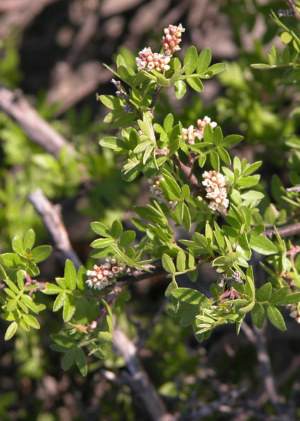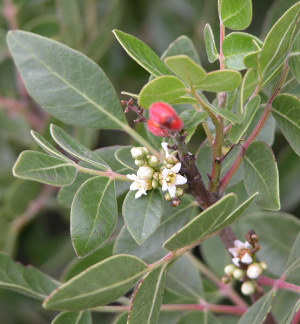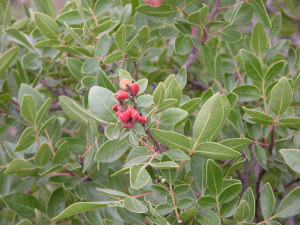Littleleaf Sumac, Evergreen Sumac
Littleleaf Sumac ( Rhus microphylla Engelmann)
Evergreen Sumac (Rhus virens A. Gray)
Anacardiaceae (Sumac Family)
Close relatives of poison ivy, these two small shrubs, littleleaf sumac and evergreen sumac, are widespread across the western Edwards Plateau and Trans-Pecos regions, as well as much of the Southwest. These shrubs are widespread throughout the Lower Pecos, growing in locally dense patches. Both shrubs were used for food and drink and were a component of the Native American pharmacopoeia (herbal medicines).
Evergreen sumac is an evergreen shrub or small tree. It has alternately arranged, shiny deep green pinnately compound leaves with five to nine leaflets. Littleleaf sumac is a deciduous shrub or small tree with alternately arranged, pinnately compound leaves with five to nine leaflets. Each leaflet measures about 0.75 inches long and 0.25 inches wide, much smaller than other sumacs in the region. Both sumacs have an acidic, astringent orange-red fruit, with a single seed that measures less than 5 mm.
Archeological occurrence. Seeds and fruit of littleleaf sumac were recovered from Middle and Late Archaic midden deposits and a cache of evergreen sumac leaves was noted in Early Archaic deposits of Hinds Cave (Dering 1979). Other reports of this plant from archeological deposits in the region are lacking, primarily because unscreened deposits of other sites have yet to be analyzed.
Food and beverage. It's prudent to repeat here that sumac is a close relative of poison ivy as both are members, along with the mango tree, of the same plant family. If you are allergic to any of these plants, you might experience a nasty reaction from consuming sumac fruits or even handling the leaves, bark, or wood.
Although littleleaf sumac is mentioned in ethnobotanical references, evergreen sumac is not. Across the Southwest the most frequently mentioned Rhus in Southwestern ethnography is skunkbush, Rhus trilobata. Castetter and Opler (1936:48), however, specifically note that littleleaf sumac was utilized in the same manner as skunkbush. This author has used littleleaf sumac fruit in many of the same ways described for skunkbush, with the exception of the medicinal applications.
The fruit is eaten fresh and ground into meal by the Navajo (Castetter 1935:49). The Cahuilla, Comanche, and Hopi ate the fresh berries (Bean and Saubel 1972:131; Carlson and Jones 1940:527; Hough 1898:143). The Mescalero Apache mixed baked agave with sumac fruits and dried the mixture for storage (Castetter and Opler 1936:37). They gathered the red fruits from midsummer to fall and sun-dried them. The dried fruit was ground between flat stones and made into jam or mixed with sunflower seeds (Castetter and Opler 1936:46). The Havasupai gathered and dried the fruits for winter storage and use (Weber and Seaman 1985:229).
Several groups used the berries to make beverages or soups. The Havasupai crushed the berries and mixed them with water to make a drink (Weber and Seaman 1985:229). The Cahuilla ground the berries into flour and added it to soups (Bean and Saubel 1972:131).
Weaving. Twigs of skunkbush (Rhus trilobata) were used for basketry by many groups. This author has found that the twigs of evergreen sumac are particularly pliable and probably functioned well in that capacity. Groups using skunkbush twigs for basketry or other weaving include the Hopi (Fewkes 1896:16; 1897:40), White Mountain Apache (Reagan 1928:160), Cahuilla (Bean and Saubel 1972:131), Ramah Navajo (Vestal 1952:35), Tewa (Robbins et al. 1916:49), and Zuni (Stevenson 1915:81).
Medicine and ritual. Sumac had several medicinal and ceremonial applications. The Comanche chewed the bark and swallowed the resulting juice for treating colds (Carlson and Jones 1940:524;534). In California, the Indians of Round Valley applied the dried and powdered berries to smallpox sores (Chesnut 1902:365). The Ramah Navajo had many uses for sumac. They used the leaves to cause impotency as a form of birth control, and also used the bark of the root to help expel the placenta during childbirth. The leaves were also chewed for a stomach ache, a practice one might avoid if they were interested in remaining potent (Vestal 1952:35-36). The buds were considered medicinal by the Hopi and the twigs were used in ceremonies (Fewkes 1896:16). The Hopi also used sumac limbs for prayer sticks (Colton 1974:356). The dried shrub is used as one of the prescribed fuels for the kiva by the Hopi (Fewkes 1896:16).
References:
Bean, Lowell J. and Katherine S. Saubel
1972 Temalpakh: Cahuilla Indian Knowledge and Usage of Plants. Malki Museum Press. Morongo Indian Reservation, Banning, California.
Chesnut, Victor King
1902 Plants Used by the Indians of Mendocino County, California. Contributions from the U.S. National Herbarium 7(3):291-422.
Carlson, Gustav G. and Volney H. Jones
1940 Some Notes on Uses of Plants by the Comanche Indians. Papers of the Michigan Academy of Science, Arts, and Letters 25:517-542.
Castetter Edward F. and Morris Opler
1936 The Ethnobiology of the Chiricahua and Mescalero Apache: A, The Use of Plants for Foods, Beverages, and Narcotics. Ethnobiological Studies in the American Southwest. Vol. III. The University of New Mexico Bulletin, Biological Series 4(5). Albuquerque, New Mexico.
Colton, Harold S.
1974 Hopi History and Ethnobotany. In Hopi Indians, D. A. Horr (ed.), pp. 322- 375. Garland: New York, New York.
Dering, J. Philip
1979 Pollen and Plant Macrofossil Vegetation Record Recovered from Hinds Cave, Val Verde County, Texas. Masters thesis, published by the Department of Anthropology, Texas A&M University, College Station, Texas.
Fewkes, Jesse Walter
1896 A Contribution to Ethnobotany. The American Anthropologist 9:14-21.
1897 The Hopi in Relation to their Plant Environment. The American Anthropologist 10(2):33-44.
Hough, Walter
1898 Environmental Interrelations in Arizona. The American Anthropologist 11(5):133-155.
Reagan, Albert D.
1928 Plants Used by the White Mountain Apache Indians of Arizona. The Wisconsin Archeologist 8:143-161.
Robbins, Wilfred Wiliam, John Peabody Harrington, and Barbara Freire-Marreco
1916 Ethnobotany of the Tewa Indians. Bureau of American Ethnology Bulletin 55. Smithsonian Institution, Washington, D.C.
Stevenson, Matilda Coxe
1915 Ethnobotany of the Zuni Indians. Thirtieth Annual Report of the Bureau of American Ethnology, [1908-1909], pp. 35-103. Washington, D.C.
Vestal, Paul
1952 Ethnobotany of the Ramah Navaho. Papers of the Peabody Museum of American Archaeology and Ethnology 40 (4). Harvard University. Cambridge, Massachusetts.
Weber, Steven A. and P. David Seaman
1985 Havasupai Habitat: A.F. Whiting's Ethnography of a Traditional Indian Culture. University of Arizona Press, Tucson, Arizona.
![]()


